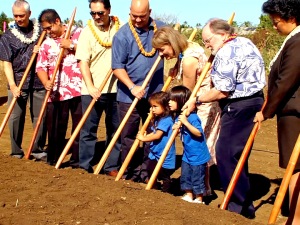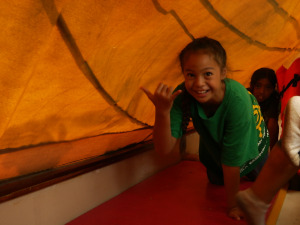The Mālama ʻĀina Field School in Nanakuli focuses on helping incoming 8th and 9th graders of Nanakuli to develop and enhance math, science and reading and writing skills, while engaging in outdoor, field activities.
“This is a brand new idea and initiative that many different partners have been thinking about for some time.We’ve been meeting informally on how we can make education, especially along the Waianae coast, more meaningful and engaged students more.” says Executive Director of Mālama Learning Center, Pauline Sato.
The Ka Pua initiative from Kamehameha Schools is one of the organizations involved in this program.
“They saw that this is an innovative program; that they wanted to be a part of. And their real interest is especially in math and boning up and strengthening those math skills.” says Pauline Sato.
“This is huge for me, like I think this is how kids should learn. The whole point is making it relevant for them and seeing why they should learn these concepts.” says 7th-8th Grade Nanakuli Science Teacher, Terra Wight.
“It’s not boring, it engages us even more into, ‘oh why did this happen?’… It gets us more interested. It’s very different because it’s hands on and I feel it’s more personal.” says Galilee Kamai, an incoming freshman at Nanakuli School.
“It’s relevant, and it’s challenging, it’s really- the stuff they’re doing is really challenging. They’re seeing their work being valued and they’re seeing the challenge pushing, like kind of realizing… you’re doing college level work, you can do this stuff…” says Terra Wight.
Pauline Sato says that, “it’s that college readiness, graduating form High School, going to college, having those core skills paʻa, solid with the students is really important. It’s not just in the classroom, but like how does it apply to real life?”
Along with applying these mathematical and scientific studies to field research and college preparation, the students engage in something even more educational and inspiring.
“This is about our place, about where these kids live.” says Pauline Sato.
“The most interesting thing about this summer program is being able to work in our own community and, you know, make a difference in our community.” says Galilee.
“It’s just kind of, empowering them and having them see the real relevance. Especially starting in our home.” says Terra Wight
Galilee says that, “our first trip that I went on was our hike to Palikea. So if we look down, we can see our whole valley. And we saw it in a different perspective. Now we have a different feeling about our community; we feel that it’s a very beautiful place and we should take care of it.”
Pauline Sato says that, “we’re kind of looking at the whole picture; what impact do we have on our environment…to try to get the students to think beyond today, but tomorrow – and also their kuleana to their community.”
Terra Wight says that, “we can raise the bar a little higher, and these kids can meet challenges. We are seeing it here, and I think we can see it in the school year.”




